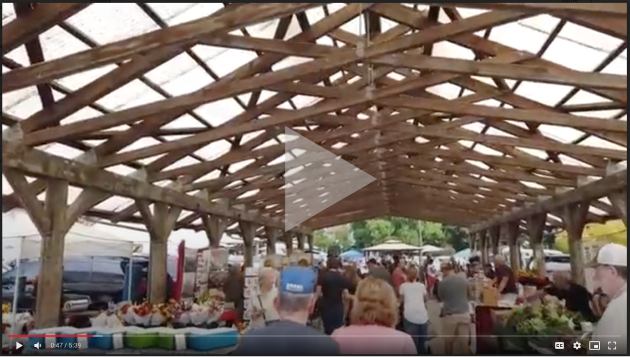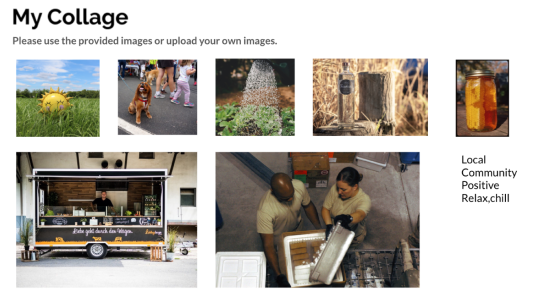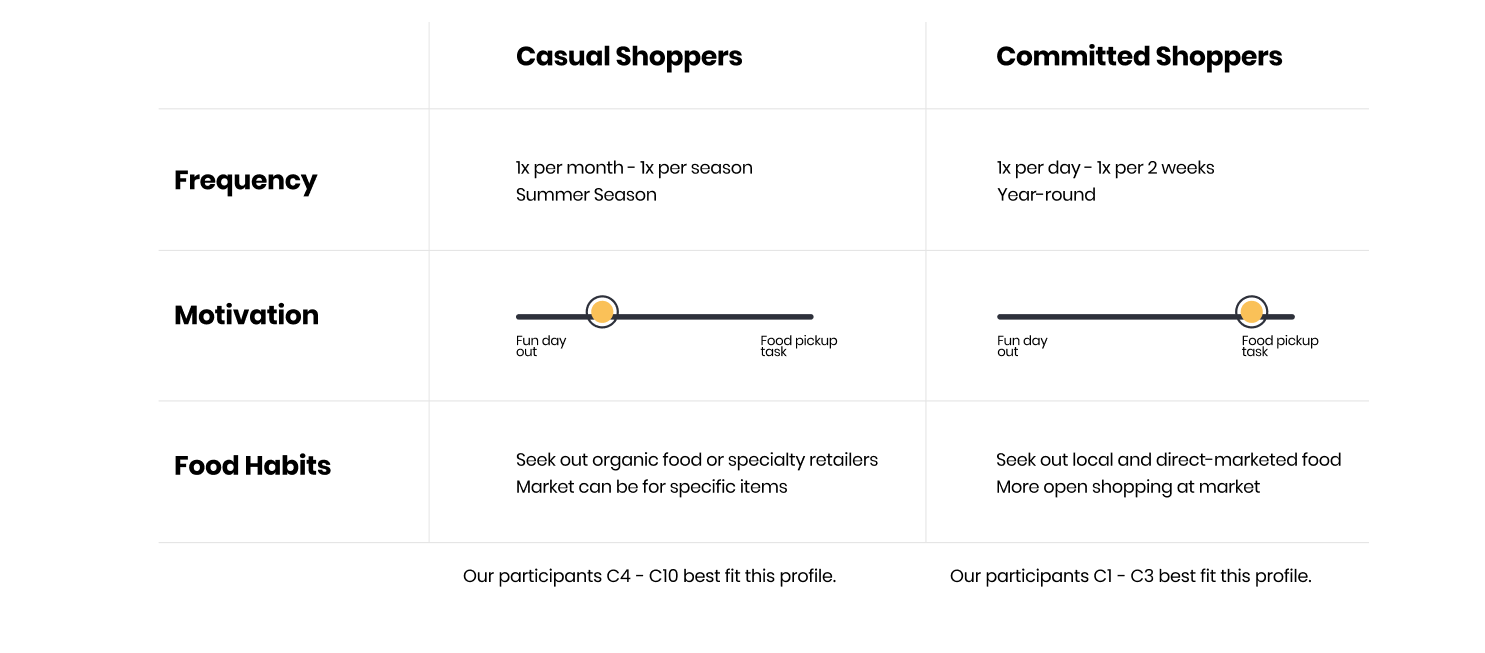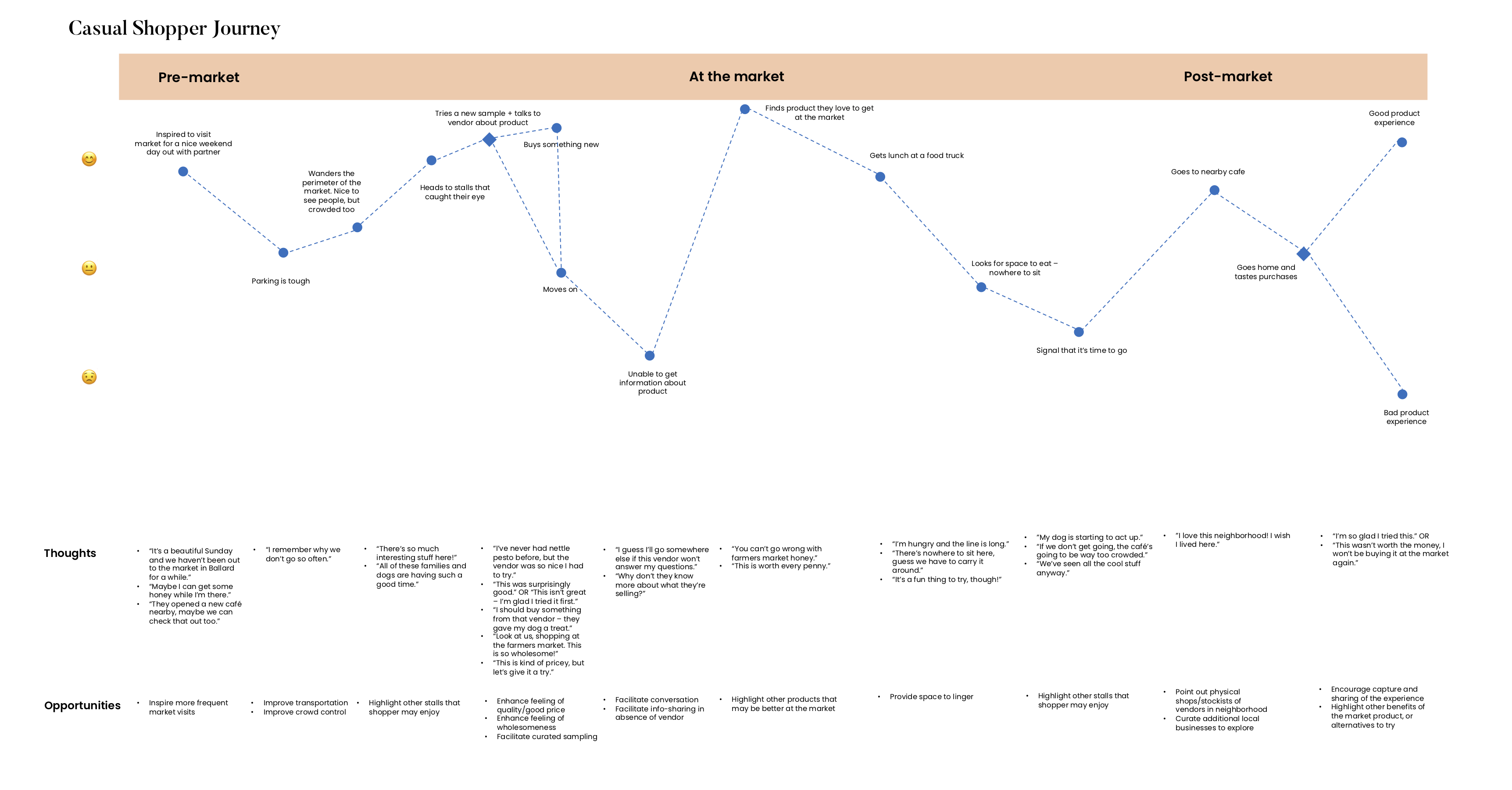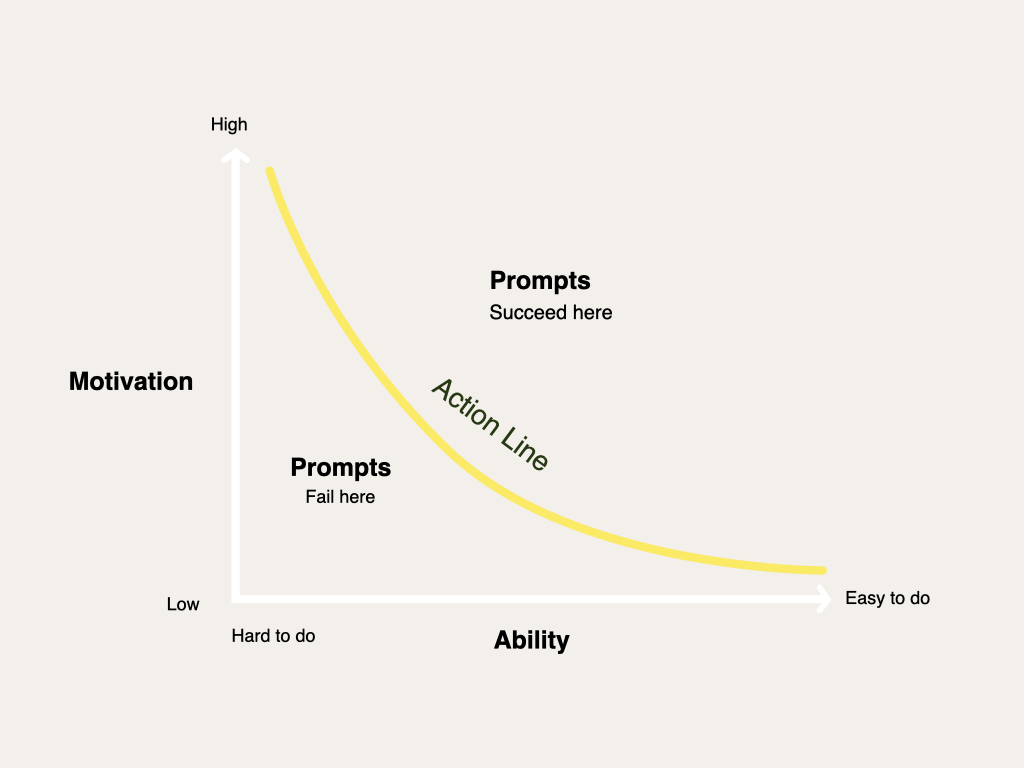fava
Bringing foodies back to their local farmers markets and encouraging human connection in the face of COVID-19 pandemic restrictions.
Capstone project sponsored by Deloitte Doblin. March – August 2020. Lead UX researcher, service designer, UX copywriter.
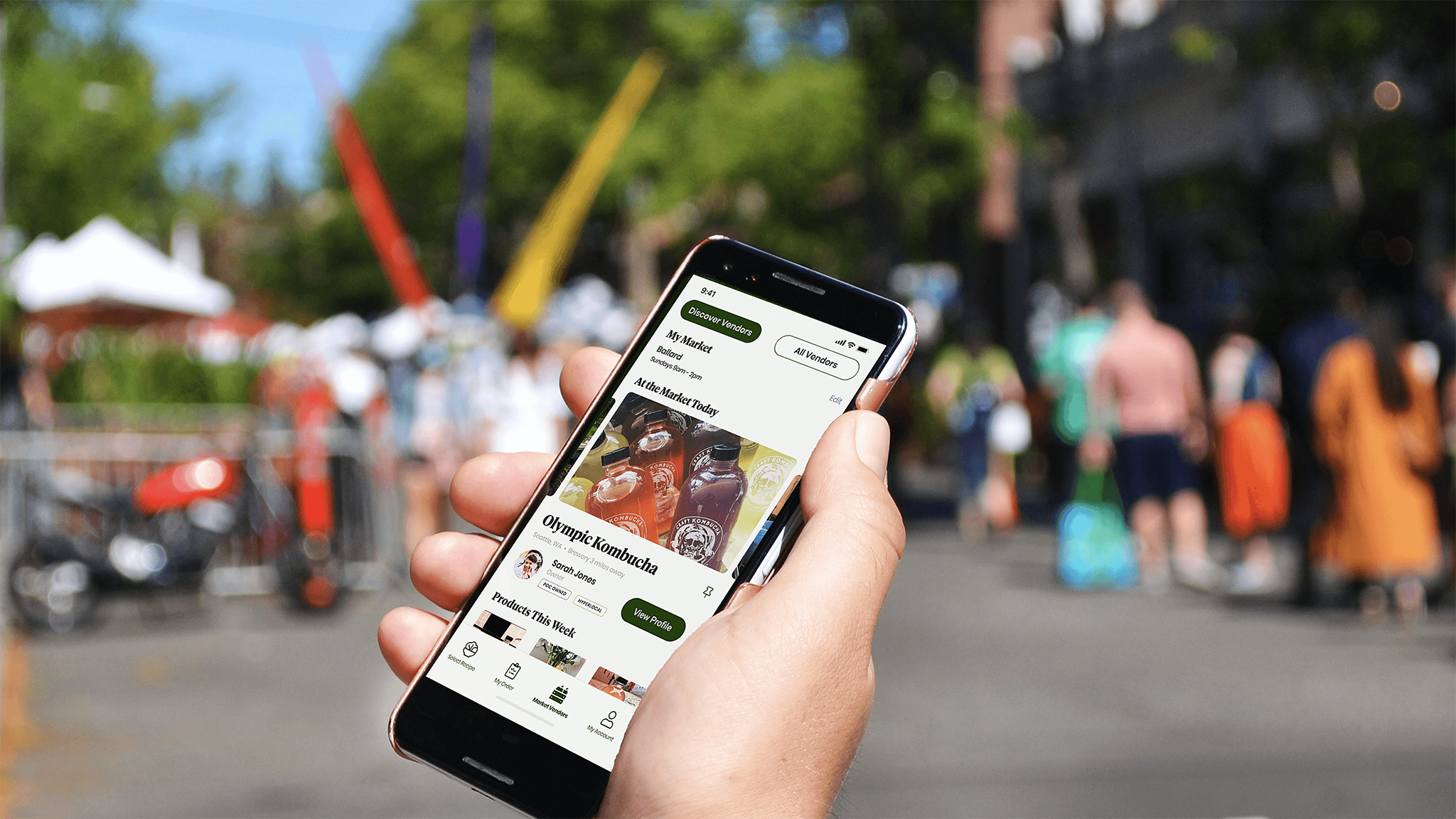
Problem
In many cities, farmers markets are the most accessible spaces for people to connect with their local food systems and experience a more sustainable, environmentally-conscious approach to agriculture. For some, this stops at an occasional fun outing. For others, this connection becomes a habit and reshapes the way that they see food and farming. Our UW MHCI+D capstone project team (Jean He, Rachel DeNoble, and I) was curious about what moved people from one behavior to the other — especially in a place like Seattle where farmers markets are frequent and plentiful.
The COVID-19 pandemic (which picked up just as we began to plan our project), added an extra dimension: since the pandemic began, attendance at Seattle farmers markets was estimated by organizers to have dropped by as much as 90%. This created a crisis for small local farmers, who depended on market sales for 40-75% of their income.
What could we do to bring people back to their local farmers markets?
Process
Exploring the terrain
It's not often that you're given a completely open project brief. To drill down to the problem that we wanted to solve, I led a discovery research phase to answer 2 key questions:
- What role do farmers markets play in the Seattle-area food system and within the communities in which they operate?
- How do farmers markets fit into shoppers' lives, and what motivates people to take a trip there?
From literature review and interviews we conducted to answer these questions, I began to see relationships between shoppers and vendors emerging as a theme among advocates and more frequent, committed shoppers.
Research question 3 was born:
3. How do market vendors and shoppers create and maintain connections?
My research plan involved a mix of traditional literature reviews and expert interviews (with 6 food system academics, activists, and staff from the organizations that operate Seattle and Washington's farmers markets), followed by online qualitative interviews and activities with 15 farmers market shoppers and vendors. Activities like digital collage-making and having participants take us on a virtual 'walk-through' of a farmers market using a pre-COVID video, helped us get the rich insights that would normally be accomplished through activities like contextual inquiry during a farmers market trip.
I supplemented our interview insights by qualitatively coding comments from shoppers and vendors on a selection of farmers market-related social media posts on Facebook, Instagram, and Reddit. This helped us roughly gauge what themes resonated when considering a larger shopper pool.
Understanding farmers market shoppers
I worked with my team to sift through the information by affinity mapping to come up with themes, hypotheses, and insights. We plotted our key insights on a systems map of the local food ecosystem, which helped us pinpoint actors and spaces that we could affect with our design intervention.
With the intention of getting as close to a microcosm of Seattle as possible, our team interviewed users representing a variety of demographic profiles. However, their attitudes and behaviors towards farmers markets broadly aligned. Personas seemed reductive in this case, so instead I facilitated a mapping of our shoppers' behaviors along spectrums (for example: how often they visited the market pre-pandemic, whether they bought pre-made products or raw ingredients, etc.) to create 2 archetypes: casual and committed farmers market shoppers.
Click to enlarge
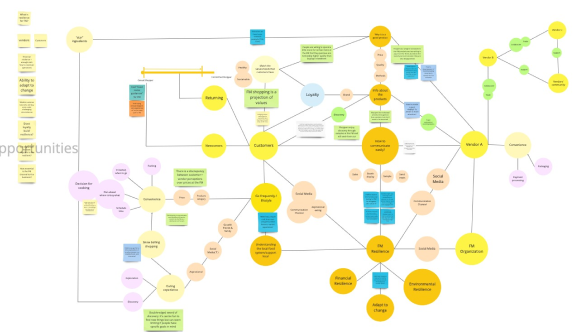
Systems map with insights

Shopper spectrums
I also created journey maps of each archetype, highlighting opportunities to extend or improve their market experience. Here's my map for casual shoppers:
Click to enlarge
Based on data from market staff and supplemented by our interviews, committed shoppers continued to visit their local markets during the pandemic. They, and vendors, underlined loyalty and relationships built over time as the cause.
Casual shoppers (who made up the majority of pre-pandemic farmers market visits) were responsible for the steep drop in market guest counts and purchases. They embodied the value-action gap: while many continued to see themselves as quality-obsessed foodies and/or ethical consumers seeking out unique, organic, and local foods; they forgot about farmers markets when visits were no longer an engaging experience. They did, however, continue to seek out specialty ingredients and experiment with gourmet foods — now, largely at home.
Our team made a slight pivot based on what we'd learned as the pandemic continued to rage: we would target increasing casual shoppers' commitment and loyalty to market vendors in order to promote resilience for Seattle's farmers markets.
You can take a look at the discovery research report for more details.
Sowing seeds of behavior change
To bridge the value-action gap and build a habit of going to the farmer's market, I turned to behavioral science. During brainstorming, I found and introduced the Fogg Behavior Model to help with ideation. According to the model, a behavior happens when motivation, ability, and a trigger come together. At the time of the trigger, the user's motivation and ability to act need to be at a threshold that allows them to make the behavior.
- Motivation can come from physical (pleasure/pain), emotional (hope/fear), or social (acceptance/rejection to a group) sources.
- Ability comes from simplifying the time, financial, physical or social effort, societal acceptance, and/or routine apect of a behavior.
- Triggers, or cues, prompt people to complete a specific behavior at a certain time. Triggers range from mere reminders, to combinations of reminders with a motivating or simplifying element.
Our casual shoppers might have some motivation and ability to check out their local markets, but it made sense to try to increase both as well as providing appropriate triggers. I guided our team through brainstorming sessions to develop a service experience that would help users make farmers markets more of habit in their lives during a time of upheaval.
Product
The concept
The product we came up with is fava: an app and service that bridges existing and aspirational user habits, while returning connection and discovery to the farmers market experience.
Triggering the trip
fava integrates seamlessly into shoppers' existing cooking and shopping routines. They can input a URL into the app or take a photo of a recipe to see which ingredients are available at their local farmers market. In this way, fava repurposes the cooking and recipe-browsing cue that casual shoppers (and many Americans — cooking at home increased during the pandemic) experience almost daily, into a cue to visit their local market.
Shoppers can reserve and pay for the ingredients that they need in advance, creating a financial incentive to carry out their intention to visit their local market. As a side benefit, this step also helps vendors plan ahead for the market.
Upping ability by making it easy
Casual shoppers don't have the patience to hunt for specific ingredients at their local market, nor go-to vendors to visit. To support ability, the service needed to make the farmers market experience as simple and convenient as a typical grocery run.
On market day, fava makes the shopping journey easy by guiding shoppers to the vendors who have their ingredients on hand (thanks to the power of Bluetooth). Pre-ordered ingredients are packed and waiting for their arrival. For any ingredients unavailable at the market that day, shoppers are directed to a nearby grocery store.
fava also makes it easy for shoppers to learn about vendors' specialty ingredients, practices, and tips — they're all in the app. Personal touches like farm photos, Q&As, and audio clips help shoppers get to know vendors even before they meet in person.
Motivating shoppers before and after the trip
To support motivation, the service had to generate excitement about and during a market trip and create a sense of belonging with vendors and the market community. Many of our casual shoppers noted sampling to be a highlight of their farmers market experience. To bring safe sampling into to an efficiency-driven journey, we developed the 'market mystery picks' feature. For a small fee, shoppers can add a mystery item (fruit, vegetable, or artisanal prepared product) to their purchase that will only be revealed when they reach the right spot on their map.
After the trip, fava extends the market experience by underlining to shoppers how their purchases align with values that they have identified with. If the user has enabled it, fava can prompt them with recipe ideas to inspire their next cooking adventure and market trip. After a few repeated trips to the market, the hope is that casual shoppers will start to build vendor relationships of their own.
A usability testing gut-check
Between the concept and the final product, I led 2 rounds of usability testing with 10 users. I prioritised our findings by frequency, severity, and difficulty to implement. Usability testing led to improvements like clearer UX copy, a less prescriptive map which outlined relative positions rather than a set path through the market, and changes to the layout of vendor profiles. Though people may not be accurate predictors of their future behavior, we also received significant feedback about how fava would entice them to visit their local farmers markets.
As a task within our usability testing, I conducted some concept testing of the 'market mystery picks' feature versus an alternative feature spotlighting seasonal produce through trivia. Users experienced both features in random order. Mystery picks, while more contentious, also generated more comments expressing curiosity and interest among users who opted to engage with it. This led our team to prioritise this option.
Final
Explore fava for yourself, from sign-up to order and pickup. The blue highlights will guide you to clickable areas if you get lost.
Payoff
Growing impact
- Stakeholder recognition: We took our final designs back to the market managers and directors of the Queen Anne Farmers Market, Seattle Farmers Market Association, and Washington State Farmers Market Association, and received positive feedback. One market director remarked that he could see the service returning the human element to the market shopping experience that he felt was under threat with new safety processes, while keeping people safe. Another director mentioned both anecdotes and hard research data that they had, supporting the notion of symbiosis between seasonal recipes and attracting users to market products. A few of our usability tester shoppers and vendors asked when the product would be released!
- University recognition: The University of Washington Graduate School communications team chose our project to show how a team could pivot qualitative research and design to an online-only environment.
Food for thought
If I were to do it again, I would:
- Mind the business model: Towards the end of the project, I ran some calculations to see whether this product could become a viable business by collecting a percentage of sales made through the fava platform. To break even, it would need to process thousands of monthly transactions, requiring a presence in multiple states. In the absence of such a footprint, fava would need to charge additional fees to market organizers (which would be infeasible without external support like government grants). An innovative service can't exist without financial viability, and I should have considered cost and ways to adjust the business model to account for it, earlier on.
- Get creative with rigourous usability testing: Our usability tests helped gauge users' impressions of fava's features, but were isolated to 60-minute sessions while fava's theory of change depends on affecting daily or weekly habits. A supplemental Wizard of Oz-style test by sending users ingredient tips over text/email over a few days or weeks, could help us see whether having information about nearby market ingredients while choosing recipes actually affected user inclinations or behavior.
Made with <3 in Toronto and Seattle.
